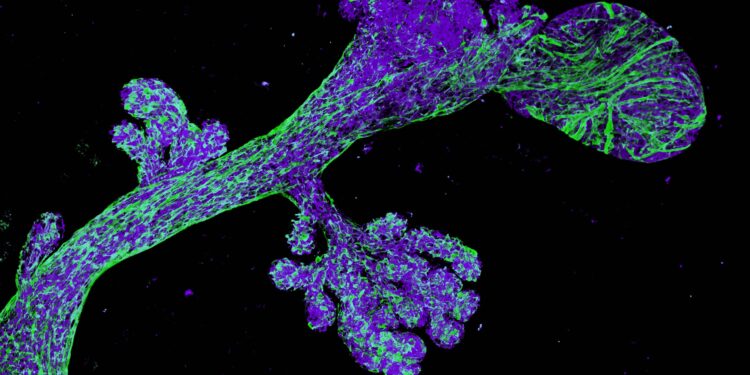Precancerous breast tissue from a BRCA2 mutation carrier. Credit: Dr Bianca Capaldo, WEHI
Women who inherit and carry a defective BRCA2 gene have a significantly increased risk of developing breast cancer: approximately 70% of carriers will develop the disease during their lifetime.
These cancers often occur at a young age and can be clinically aggressive. Early detection is encouraged and some women undertake preventative breast surgery (mastectomy) to reduce their risk of breast cancer.
In a landmark discovery published in Natural cellular biology, researchers from the Walter and Eliza Hall Institute (WEHI) have discovered the likely “cells of origin” of cancer in BRCA2 carriers. By comparing cancer-free tissue samples from carriers and non-carriers, they identified an aberrant population of cells that divided more rapidly.
Dr Rachel Joyce, co-author of the study, said this disrupted cell population was found in the majority of tissue samples from women with a faulty BRCA2 gene.
“Since they were found in most BRCA2 tissue samples from healthy women, we believe these may be the original cells that lead to future breast cancers in women. women with the BRCA2 mutation,” said Dr. Joyce.
From left to right: Dr. Rosa Pascual, Professor Geoff Lindeman, Professor Jane Visvader and Dr. Rachel Joyce. Credit: WEHI
Treatment targets
The aberrant BRCA2 tissue cells, a subset of mammary ductal cells called luminal progenitor cells, stood out to the scientific team because they exhibited impaired protein production, which is essential for the proper growth and function of our body’s tissues. .
“These changes may also make cells more vulnerable to certain therapies aimed at preventing or delaying the development of breast cancer,” said study co-author Dr. Rosa Pascual.
Lead author Professor Jane Visvader said the team developed a preclinical BRCA2 model showing similar alterations in ductal cells and targeted them with the existing cancer drug everolimus, approved to treat patients with the disease. of relapsed breast cancer.
“By identifying this vulnerability in protein production, we were able to show that pretreatment with this drug delayed tumor formation in the preclinical model,” said Professor Visvader, co-head of the Cancer Biology and Stem Cells Division. of ACRF and the WEHI Breast Cancer Laboratory.
“This raises the possibility that targeting specific aspects of protein production in this way could represent a new strategy for breast cancer prevention in women with a defective BRCA2 gene.”
Towards prevention
These results constitute an important first step towards the goal of preventive treatments for breast cancer in BRCA2 mutation carriers.
Study author and oncology clinician Professor Geoff Lindeman said while the results were exciting, further work was needed before they could be applied in the clinic.
From left to right: Dr. Rachel Joyce, Dr. Rosa Pascual and Professor Jane Visvader. Credit: WEHI
“Although everolimus delayed tumor development in the laboratory, this drug may have side effects, which could limit its ability to be used as a preventative treatment,” said Professor Lindeman, co-head of the division. Cancer Biology and ACRF Stem Cells at WEHI. , and a medical oncologist at the Royal Melbourne Hospital and the Peter MacCallum Cancer Centre.
“Our team wants to further explore which specific parts of protein processing are dysregulated and use this information to develop more selective and tolerable preventative treatments.
“There is still a way to go, but we are on a big step forward.
“A few years ago, we identified the cells of probable origin of breast cancer in women carrying a defect in the BRCA1 gene, which is also associated with a high risk of developing breast cancer. This research has has since led to an international Breast Cancer Prevention (BRCA-P) study. We hope that our new results will now inform future treatment and prevention of women with a defective BRCA2 gene.
More information:
Rachel Joyce et al, Identification of aberrant luminal progenitors and mTORC1 as a potential target for breast cancer prevention in BRCA2 mutation carriers, Natural cellular biology (2024). DOI: 10.1038/s41556-023-01315-5
Provided by the Walter and Eliza Hall Institute
Quote: Study identifies ‘cells of origin’ of breast cancer in high-risk women (January 16, 2024) retrieved January 16, 2024 from
This document is subject to copyright. Except for fair use for private study or research purposes, no part may be reproduced without written permission. The content is provided for information only.



